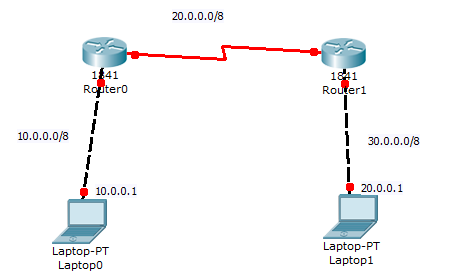Routing Information Protocol Guide


slashroot have already explained about the static routing configuration on cisco routers
Now today we are going to explain you about the Routing Information protocol(RIP) on CISCO Devices.RIP is oldest routing protocol which is still in use.Routers with RIP configuration Periodically broadcast the entire routing table to the network.And this broadcast result in precious bandwidth wastage.And also it have no mechanism to authenticating other routers.
Methods of Routing
A router can forward packets to non-directly connected device in two ways.
- Static Way (Static Routing)
- Dynamic Way (Dynamic Routing
Static Routing: In this type of Routing we enters the routers manually and configure and if there is any change in topology of network, we need to manually change the route.
Dynamic Routing: This type of routing once configured automatically learns routing table and update the routing table if there is any change in network topology .
RIP Comes under Dynamic Routing. We have already posted about Static Routing Configuration.Here we are going to explain about a Dynamic Routing Protocol RIP.
INTRODUCTION TO RIP(ROUTING INFORMATION PROTOCOL)
- RIP Version-1 was the Internet's first widely used routing protocol.
- RIP is simple to configure
- It has large support base.
- RIP version 2 support for VLSM.
- All the Cisco routers support RIP-V1.
- And Yeah RIP Version 2 support was integrated later and is implemented into IOS Version 11.1.
- RIP is Distance Vector,Interior Gateway Routing Protocol.
- It works fine in small network, because for RIP maximum allowable hopcout is 15. So a network where more than 15 hops are available RIP can't be used or implemented there.It's on of RIP limitation.
- RIP uses a distance vector algorithm .
Limitations of RIP
- RIP is useful in some situations, but before its implementation you must know its limitations.
- RIP Version 1 of the protocol is a purely classful.
- RIP has no support for VLSM(Variable Length Subnet Mask). So it can't be used if you are thinking to use complex subnetting.
Features Of RIP(Routing Information Protocol)
- One of the central features of RIP is that it distributes the entire routing table every 30 seconds.
- you to control how much incoming RIP update information the router can hold before it has can process the information and integrate it into its routing table.
- RIP authentication is one of the protocol enhancements that appeared in RIP Version 2.
- Note: RIP Authentication is not available for Version 1.
- it is much easier to configure than BGP as a method for interconnecting two or more different Autonomous Systems like OSPF or EIGRP.
Difference between RIP-v1 and RIP-v2
- RIPv1 uses local broadcasts to share routing information. Whereas RIPv2 uses multicasts instead of broadcasts.
- RIPv1 updates are periodic in nature while RIPv2 supports triggered updates. when a change occurs.
- RIPv1 support classful routing only while RIPv2 support classless routing protocol too.
- RIPv1doesn't support VLSM, while RIPv2 supports VLSM.
ROUTING INFORMATION PROTOCOL in a flash.
RIPv1:
- It is Classfull
- IGP(Interior Gateway Protocol)
- It is Dynamic
- Type of Distance vector Ruoting Protocol
- Metric [hop count (max-15)] (doesn’t work based on bandwidth but hop count)
- Bell Man Ford Algorithm
- Maximum Path = default 4 / maximum 6
- Port no.= 520
- UDP
- Send broadcast at 255.255.255.255
Now have a Look about RIP Timers:
· Send updates every 30 sec
· Invalid a route 180 sec
· Hold time 180 sec
· Flush out a route 240 sec
Note: If router does not send subnet mask info to the network known as class full address.
Administrative Distance:
We can define it as the trusting route for a particular destination, if there are mode than one routing protocols running in a router, RP with lower AD is used)
RIP V2
- · It is Classless / VLSM
- · Here Authentication is optional.
- · Trigger Updates (Send update immediately, if there is change in the routing table)
- · Multicast: 224.0.0.9
- · AD = 120
In the Next Post we will learn how to configure RIP on cisco routers.

Here you can see two laptop laptop0 and laptop1.
Both laptop machines are in a different network.
Now to make them possible talk to each other we need router because both are in a different network.
Now we have already seen in my previous post that how to make them talk with each other or how to make machines from different network talk with each other using static routing.
Now here we do the same but by Dynamic Routing using RIP.


 Sarath Pillai
Sarath Pillai Satish Tiwary
Satish Tiwary
Add new comment